teratoma


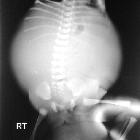
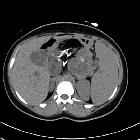


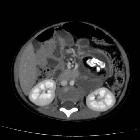







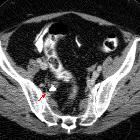
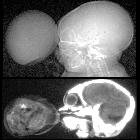

Teratomas are germ cell tumors that arise from ectopic pluripotent stem cells that fail to migrate from yolk sac endoderm to the urogenital ridge during embryogenesis. By definition, they contain elements from all three embryological layers: endoderm, mesoderm and ectoderm although frequently, elements from only two layers are evident.
Pathology
Teratomas range from benign, mature, well-differentiated cystic lesions to immature, poorly differentiated lesions with solid components and malignant transformation. As a result they can contain a large variety of tissue types including. On occasion, mature teratomas contain elements that undergo malignant transformation (most commonly squamous components).
- fat
- cystic spaces due to mucous production or other exocrine products
- soft-tissue from any part of the body
- calcification including teeth
Location
They are found in a variety of locations, including:
- ovary: see ovarian teratoma (also known as ovarian dermoid cyst)
- testis: see testicular teratoma
- mediastinum: see mediastinal teratoma
- account for 27% of all teratomas in adults
- account for 4-13% of all teratomas in children
- intracranial: see intracranial teratoma
- sacrococcygeal region: see sacrococcygeal teratoma
History and etymology
The word teratoma is derived from the word “teratos” in Greek which means monster.
Siehe auch:
- Teratom des Ovars
- Keimzelltumor
- Steißbeinteratom
- mediastinales Teratom
- intrakraniale Teratome
- Teratom des Hodens
und weiter:
- Rathke Zyste
- genitourinary curriculum
- Tumoren der Hypophysenregion
- Pinealiszyste
- ektope Neurohypophyse
- Tumoren des vorderen oberen Mediastinums
- Pineoblastom
- Seminom
- suprasellar cistern lipoma
- Hypophysenadenom
- Pineozytom
- Thymuslipom
- Tumoren der hinteren Schädelgrube
- pituitary region mass with intrinsic high T1 signal
- caudal dysplasia sequence
- anterosuperior mediastinal mass (mnemonic)
- mediastinale Keimzelltumoren
- Seminom des Hodens
- Krebs
- Apoplex der Hypophyse
- germ cell tumour classification
- suprasellar / hypothalamic lesions
- classification of germ cell tumours
- growing teratoma syndrome
- teratoma suprasellar
- mesenteriales Teratom
- nichtseminomatöser Keimzelltumor
- Teratom der Glandula parotis
- reifes zystisches Teratom
- Germinom des ZNS
- eingeblutete Metastasen
- Teratom des Pharynx
- intrakranieller Keimzelltumor
- Teratom der Nase
- Merkspruch Keimzelltumoren
- intracranial germ cell tumours

 Assoziationen und Differentialdiagnosen zu Teratom:
Assoziationen und Differentialdiagnosen zu Teratom:



